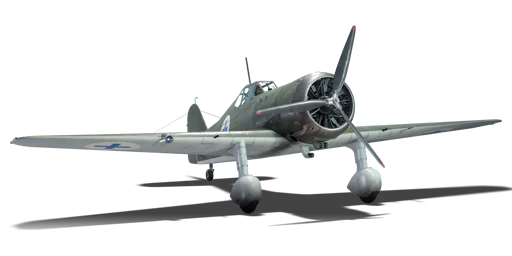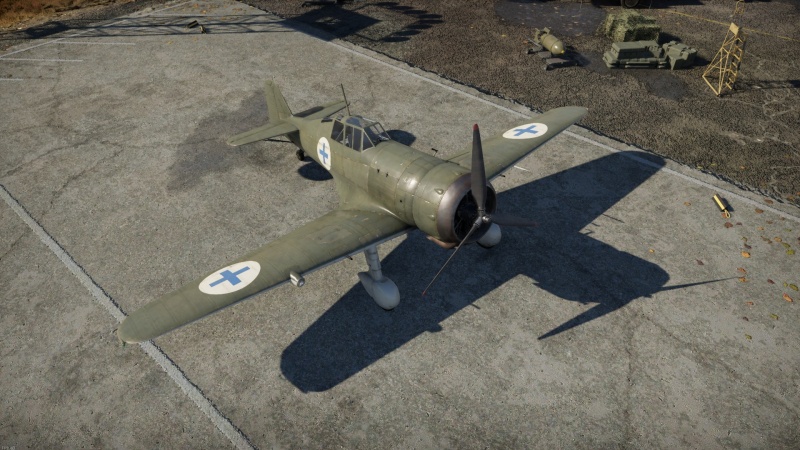Difference between revisions of "Fokker D.XXI-3 (Sweden)"
Colok76286 (talk | contribs) (Edits) |
(copied the History section of the premium fokker d20 over onto the finnish tree version as the vehicles are basically identical except for the armament which is never mentioned in this section) (Tag: Visual edit) |
||
| Line 137: | Line 137: | ||
== History == | == History == | ||
<!-- ''Describe the history of the creation and combat usage of the aircraft in more detail than in the introduction. If the historical reference turns out to be too long, take it to a separate article, taking a link to the article about the vehicle and adding a block "/History" (example: <nowiki>https://wiki.warthunder.com/(Vehicle-name)/History</nowiki>) and add a link to it here using the <code>main</code> template. Be sure to reference text and sources by using <code><nowiki><ref></ref></nowiki></code>, as well as adding them at the end of the article with <code><nowiki><references /></nowiki></code>. This section may also include the vehicle's dev blog entry (if applicable) and the in-game encyclopedia description (under <code><nowiki>=== In-game description ===</nowiki></code>, also if applicable).'' --> | <!-- ''Describe the history of the creation and combat usage of the aircraft in more detail than in the introduction. If the historical reference turns out to be too long, take it to a separate article, taking a link to the article about the vehicle and adding a block "/History" (example: <nowiki>https://wiki.warthunder.com/(Vehicle-name)/History</nowiki>) and add a link to it here using the <code>main</code> template. Be sure to reference text and sources by using <code><nowiki><ref></ref></nowiki></code>, as well as adding them at the end of the article with <code><nowiki><references /></nowiki></code>. This section may also include the vehicle's dev blog entry (if applicable) and the in-game encyclopedia description (under <code><nowiki>=== In-game description ===</nowiki></code>, also if applicable).'' --> | ||
| − | + | Development of what would become the Fokker D.XXI began in late 1934 with engineers at the Fokker company seeking to design a modern fighter aircraft, incorporating some of the latest aviation technologies. In 1935, the Dutch Air Force ordered the construction of a prototype which would be evaluated by its East Indies branch, as a result of the aircraft being seen as suitable for defending Dutch overseas assets. | |
| + | |||
| + | Although its maiden flight in 1936 showed enough promise, the fate of the Fokker D.XXI was "hanging in the air" for a time due to a change in doctrine within the Dutch Air Force. As a result, Fokker began looking into promoting the aircraft on the export market, hoping to find foreign customers. | ||
| + | |||
| + | Fortunately, Fokker received interest from both Denmark and Finland to purchase a number of aircraft as well as rights to production. At the same time, domestic interest was also revived, resulting in the start of production in 1937. | ||
| + | |||
| + | Despite being a Dutch design, the Fokker D.XXI was predominantly produced and employed by Finland. Having built and operated around ⅔ of all D.XXIs, the Finnish Fokkers distinguished themselves during the Winter and Continuation War, although with less success in the latter due to their dated design. The Dutch Fokkers also put up a stiff resistance to the invading German forces in May 1940, shooting down a number of enemy aircraft, including several superior Messerschmitt Bf 109s. In the end, approximately 150 D.XXIs were built, serving up until 1949 with Finnish forces. | ||
== Media == | == Media == | ||
Revision as of 13:06, 1 April 2023
| This page is about the fighter Fokker D.XXI-3 (Sweden). For the premium version, see Fokker D.XXI (Sweden). |
Contents
Description
The ▄Fokker D.XXI Series 3 is a rank I Swedish fighter with a battle rating of 1.7 (AB/RB/SB). It was introduced in Update "Fire and Ice". Apart from the armament and a bit of armour behind the pilot, it is broadly similar to the premium D.XXI: primitive but rugged, slow but very manoeuvrable. The loss in punch of its offensive armament (four 7.7 mm Brownings instead of the two 7.7 mm and two 20 mm cannon in the premium version) is partially offset by the lower BR. Even stock, the engine can be run at WEP for extended periods of time without overheating.
General info
Flight performance
The Fokker D.XXI-3 is highly agile for its class, and many opponents (except biplanes) will often struggle to get a good shot. The downside to its manoeuvrability is its speed. The Fokker D.XXI-3 is quite primitive, with only landing flaps, and fixed landing gear causing considerable drag. This makes the Fokker D.XXI-3 unable to run away from most opponents, as even some biplanes are capable of catching up. This doesn't mean the plane is weak however, as the engine provides excellent power for such a light machine, allowing it to climb high above most targets.
| Characteristics | Max speed (km/h at 5,000 m) |
Max altitude (metres) |
Turn time (seconds) |
Rate of climb (metres/second) |
Take-off run (metres) | |||
|---|---|---|---|---|---|---|---|---|
| AB | RB | AB | RB | AB | RB | |||
| Stock | 410 | 398 | 10100 | 16.7 | 17.3 | 11.3 | 11.3 | 150 |
| Upgraded | 441 | 425 | 15.5 | 16.0 | 17.7 | 14.2 | ||
Details
| Features | ||||
|---|---|---|---|---|
| Combat flaps | Take-off flaps | Landing flaps | Air brakes | Arrestor gear |
| X | X | ✓ | X | X |
| Limits | ||||||
|---|---|---|---|---|---|---|
| Wings (km/h) | Gear (km/h) | Flaps (km/h) | Max Static G | |||
| Combat | Take-off | Landing | + | - | ||
| 735 | 290 | N/A | N/A | 240 | ~15 | ~6 |
| Optimal velocities (km/h) | |||
|---|---|---|---|
| Ailerons | Rudder | Elevators | Radiator |
| < 320 | < 240 | < 500 | > 320 |
Survivability and armour
- Armour: one 9 mm steel plate behind pilot's seat
- Self-sealing fuel tanks (1 in front of pilot)
Modifications and economy
Armaments
Offensive armament
The Fokker D.XXI-3 (Sweden) is armed with:
- 2 x 7.7 mm FN-Browning M.36 No.3 machine guns, nose-mounted (500 rpg = 1,000 total)
- 2 x 7.7 mm FN-Browning M.36 No.3 machine guns, wing-mounted (300 rpg = 600 total)
Usage in battles
In dogfights, use your superior turn time to get an advantage over opponents. Keep your speed above 170 k/h while dogfighting to avoid becoming sluggish. Having a good altitude advantage is a must as this will grant your plane more energy before entering a fight.
Manual Engine Control
| MEC elements | ||||||
|---|---|---|---|---|---|---|
| Mixer | Pitch | Radiator | Supercharger | Turbocharger | ||
| Oil | Water | Type | ||||
| Controllable | Controllable Not auto controlled |
Not controllable Not auto controlled |
Not controllable Not auto controlled |
Separate | Not controllable 1 gear |
Not controllable |
Pros and cons
Pros:
- High climb rate, especially for a monoplane of this BR
- Only one fuel tank, so fires usually would not be started if the aircraft was tailed
- Great turn time
- Engine takes a while to overheat on WEP
- Sturdy airframe tolerates high speed dives
- Very stable aircraft to fly in simulator battles
- Fixed landing gear makes landings easier and more simplified
- Good armament for its BR
Cons:
- Rather slow, cannot escape fights
- Only has landing flaps
- No armour
History
Development of what would become the Fokker D.XXI began in late 1934 with engineers at the Fokker company seeking to design a modern fighter aircraft, incorporating some of the latest aviation technologies. In 1935, the Dutch Air Force ordered the construction of a prototype which would be evaluated by its East Indies branch, as a result of the aircraft being seen as suitable for defending Dutch overseas assets.
Although its maiden flight in 1936 showed enough promise, the fate of the Fokker D.XXI was "hanging in the air" for a time due to a change in doctrine within the Dutch Air Force. As a result, Fokker began looking into promoting the aircraft on the export market, hoping to find foreign customers.
Fortunately, Fokker received interest from both Denmark and Finland to purchase a number of aircraft as well as rights to production. At the same time, domestic interest was also revived, resulting in the start of production in 1937.
Despite being a Dutch design, the Fokker D.XXI was predominantly produced and employed by Finland. Having built and operated around ⅔ of all D.XXIs, the Finnish Fokkers distinguished themselves during the Winter and Continuation War, although with less success in the latter due to their dated design. The Dutch Fokkers also put up a stiff resistance to the invading German forces in May 1940, shooting down a number of enemy aircraft, including several superior Messerschmitt Bf 109s. In the end, approximately 150 D.XXIs were built, serving up until 1949 with Finnish forces.
Media
- Skins
See also
Links to the articles on the War Thunder Wiki that you think will be useful for the reader, for example:
- reference to the series of the aircraft;
- links to approximate analogues of other nations and research trees.
External links
| Royal Dutch Aircraft Factory Fokker (Koninklijke Nederlandse Vliegtuigenfabriek Fokker) | |
|---|---|
| Strike Aircraft | ◗Fokker G.IA |
| Jet Aircraft | ▄Meteor F Mk.8* · ◘Hunter F.6* |
| Export | ▄Fokker D.XXI-3 · ▄Fokker D.XXI |
| * Licensed Production / Variants | |
| See Also | Gloster · Hawker · Valtion Lentokonetehdas |
| Sweden fighters | |
|---|---|
| ASJA | J6B |
| Saab | J21A-1 · J21A-2 · A21A-3 |
| FFVS | J22-A · J22-B |
| Foreign Import | J8A · Iacobi's J8A · J9 Early · J11 · J20 · J26 David · J26 |
| Finland | |
| VL | Mörkö-Morane · VL Myrsky II · VL Pyörremyrsky |
| (NL) Fokker | ▄Fokker D.XXI-3 · ▄Fokker D.XXI |
| (DE) Messerschmitt | ▄Bf 109 G-2 · ▄Bf 109 G-6 Erla · ▄Bf 109 G-6 |
| Other | ▄B-239 · ▄Hurricane Mk I/L |





